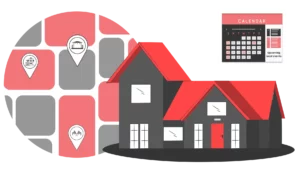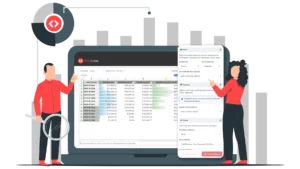In the fast-paced world of short-term rentals, managing properties can often feel like juggling flaming torches—challenging, intense, and fraught with the risk of burnout. But what if there was a way to streamline your operations and make property management feel less like a circus act? Whether you’re a seasoned pro or just dipping your toes into the short-term rental market, this blog covers short-term rental property management tips that will equip you with seven practical strategies that will simplify your management process and maximize your success.
What Is the Difference Between Short-Term Rental Management and Long-Term Rental Management?
Before we dive into how to manage short term rental effectively, let’s first understand the difference between short-term rentals and long-term rentals. As a property manager, you might want to do both to diversify your proper management portfolio. While both strategies can generate income, they involve different processes, guest types, and operational demands.
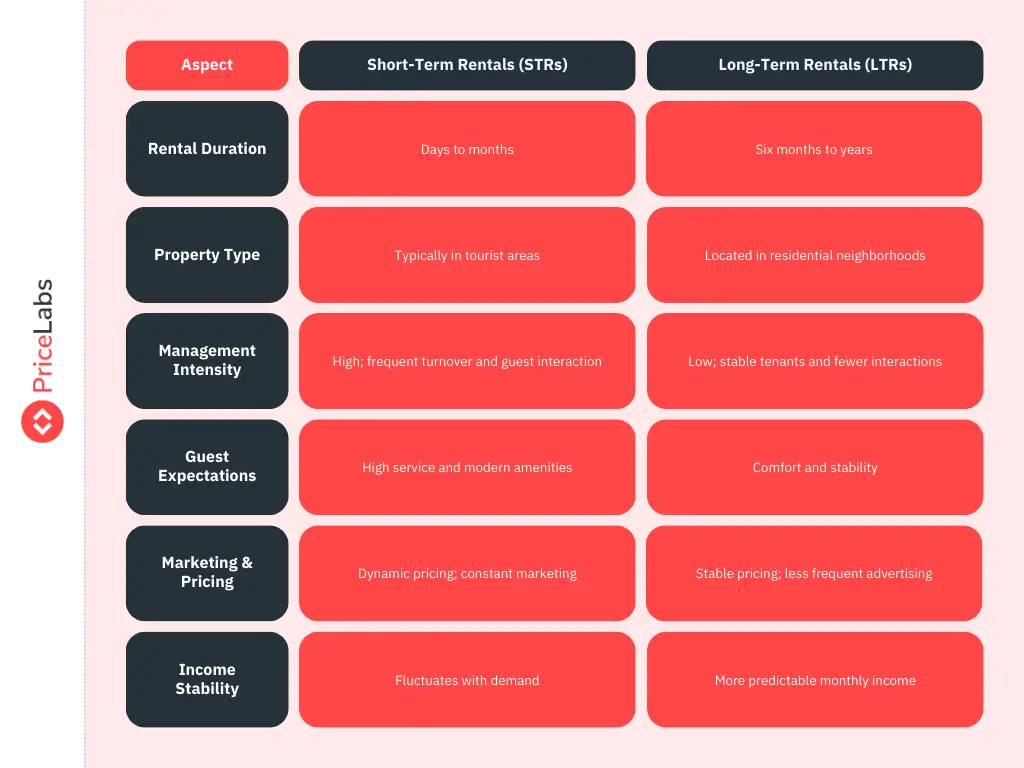

1. Rental Duration
The primary distinction lies in how long the property is rented.
- Short-Term Rentals (STRs): These rentals are typically leased for just a few days to a few months. They cater to vacationers, business travelers, and other temporary guests, which means you’ll see a high turnover of occupants.
- Long-Term Rentals (LTRs): In contrast, long-term rentals are leased for six months or longer. This approach provides a steadier income stream, as tenants commit to living in the property for an extended period.
2. Property Type and Location
The type and location of the properties can also differ significantly.
- Short-Term Rental Properties: STRs are usually found in tourist hotspots, such as city centers or near popular attractions. They often come equipped with modern amenities and furnishings to meet the needs of short-term guests.
- Long-Term Rental Properties: Long-term rentals can be located in residential areas, often appealing to families or professionals looking for stable housing. These properties prioritize comfort and practicality over luxury.
3. Management Intensity
The demands of managing these properties vary considerably.
- Short-Term Rental Management: Managing STRs is generally more labor-intensive. Property managers must handle guest communications, vacation rental marketing, and rapid turnovers, including cleaning and restocking the property after each stay. This requires a high level of organization and responsiveness.
- Long-Term Rental Management: In contrast, managing LTRs requires much less daily involvement. Once tenants are settled in, the focus shifts to rent collection and responding to maintenance requests, leading to a more predictable workload.
4. Guest Expectations and Property Standards
Guest expectations differ between these rental types, impacting how you maintain and market the properties.
- Short-Term Guests: STR guests expect a high level of service and modern amenities. Cleanliness and a well-furnished environment are a must. They affect the reviews that guests leave for your rental and positive reviews can significantly influence future bookings.
- Long-Term Tenants: LTR tenants prioritize comfort and stability. While they expect timely maintenance and a well-kept living space, the focus is more on creating a home rather than providing luxury experiences.
5. Marketing and Pricing Strategies
Marketing approaches and pricing structures differ significantly between short-term and long-term rentals.
- Short-Term Rental Pricing: STR pricing is often dynamic, changing based on demand, local events, and seasonality. Effective marketing strategies are vital for maintaining high occupancy rates, which may require consistent advertising across multiple platforms.
- Long-Term Rental Pricing: LTR prices tend to be more stable and set based on market conditions. Once occupied, these properties are typically taken off rental platforms, reducing the need for ongoing marketing.


6. Income Stability and Fluctuations
The income potential and stability vary between the two types of rentals.
- Short-Term Rental Income: STRs can yield higher income due to premium nightly rates, but this income is often less predictable. Vacation rental seasonality and competition can lead to fluctuating occupancy rates, making effective pricing strategies essential.
- Long-Term Rental Income: LTRs generally provide a steadier income stream, with monthly rent payments that make financial planning easier. The longer lease terms offer more certainty in cash flow.
Ultimately, the choice between short-term and long-term rental management depends on your goals, market conditions, and personal preferences. By understanding these differences, you can make an informed decision that aligns with your operational capabilities and financial objectives. Whether you choose the dynamic environment of short-term rentals or the stability of long-term leasing, each path offers unique opportunities and challenges.
8 Short Term Rental Property Management Tips
If you are planning to manage a short term rental then it requires streamlining of administrative tasks to avoid human-error and smooth running of the short-term rental business. Below are a few tips to follow, to streamline your short-term rental property management.
Choose The Right Platform
The first step when managing short-term rental is to decide which platforms you want to list your listing on. While you would want your own direct booking website, listing on popular platforms like Airbnb, Vrbo and Booking.com helps you reach a wider audience quickly. It also allows you to target specific groups of travelers who are a great match for your property. For instance, if your property is family-friendly, listing on a platform that caters to families can significantly boost your chances of attracting the right guests.
Using reputable platforms also brings peace of mind for both you and your guests. These sites have built-in trust and security measures that protect personal information and ensure safe transactions. When guests see that you’re using a well-known platform, they’re more likely to feel confident booking with you.
Optimize Your Listings for Searchability
Once you have chosen the platforms you want to list your property on, its time to make them as appealing to your potential guests as possible. Think of your property listing as your online storefront. The more attractive and searchable it is, the more bookings you’ll get. Use high-quality photos that showcase your property’s best features. For instance, if your rental has a stunning ocean view, make sure it’s one of the first images guests see. Incorporate keywords that potential guests might search for, like “cozy cabin in the mountains” or “luxurious downtown apartment.”
You can also use PriceLabs Airbnb Description Generator to make this task easy for you.
Streamline Your Property Maintainence
Once your guests arrive at your vacation rental, they want to feel right at home, while getting a sense of vacation. A clean and well-maintained property gives your guests that and are important elements that determine your guest satisfaction. Consider hiring a professional cleaning service to ensure that every corner shines. Invest in quality linens and toiletries to elevate the guest experience. For example, adding plush bathrobes or high-end coffee can make guests feel pampered, increasing the likelihood of repeat bookings and positive reviews.
However, it can be hard to maintain a cleaning schedule manually. There are tool like tools like Breezeway, an official Airbnb Software Partner, which can automate the cleaning process for you by scheduling and track cleaning and maintenance tasks.
Provide Enticing Amenities
The success of your short-term rental depends on how extra can you provide your guests. When people are vacationing, they want to experience a wiff of luxury. Providing amenities that brings them in the vacation mode while also providing them with the comfort of home is the key to unlock increased bookings and great guest reviews. You first want to ensure that you are providing all the necessary amenities that are expected out of a vacation rental like:
- Furnishing
- Free WiFi
- Toiletaries
- Iron
- Air conditioning
- Washing Machine
- Dryer
If your vacation rental provides a good view of the local attraction or the landscape like mountains or the beaches, then do make sure to include them in the list of amenities you offer. You can also use PriceLabs Market Dashboard to see which amenities are popular in your market and make it a point to include those in your rental.
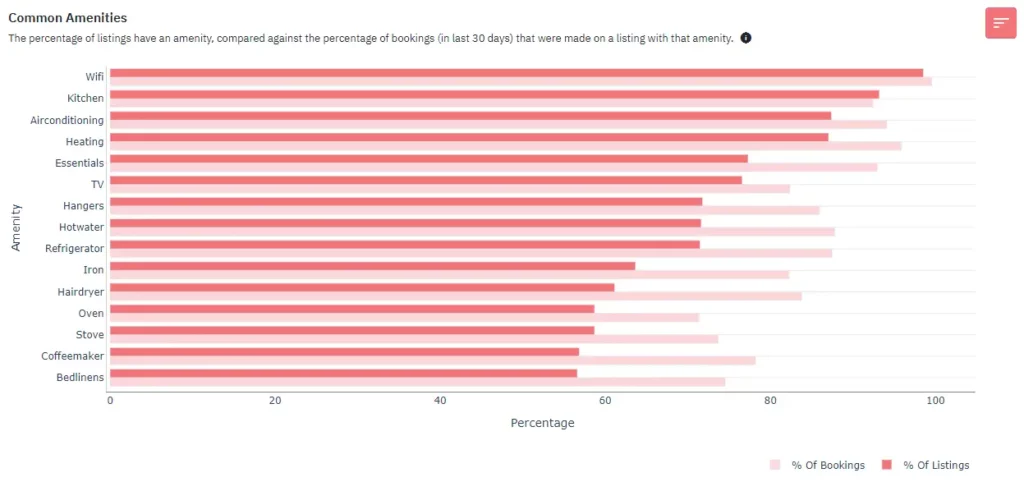

4. Add Competitive Pricing
This is arguably the most challenging aspect of short-term rental property management. To stay competitive in the market, you want to consistent adapt your pricing strategy according to shifting market trends. Your nightly price determines if a guest will book your property or not. If you price too low, you might end up giving the impression to your guests that your property is not high-end. If you charge too high, then you will price yourself out of the market. You also need to adjust your revenue management strategy according to shifting seasonality.
To price your property competitively, here are a few variables you can consider:
- Seasonality
- Location
- Events
- Holidays
- Demand
- Day of the week
Analyzing your competitor data helps with this, However, doing this manually can be time consuming and can lead to human errors. To skip the hassle, consider using PriceLabs dynamic pricing tool. A tool like this will automatically increase or decrease your prices according to market demand. The algorithm analyzes the data received daily from Airbnb, Vrbo and KeyData to analyze shifts in market demand to provide these pricing suggestions and automatically updates it on the OTAs so that you don’t have to.
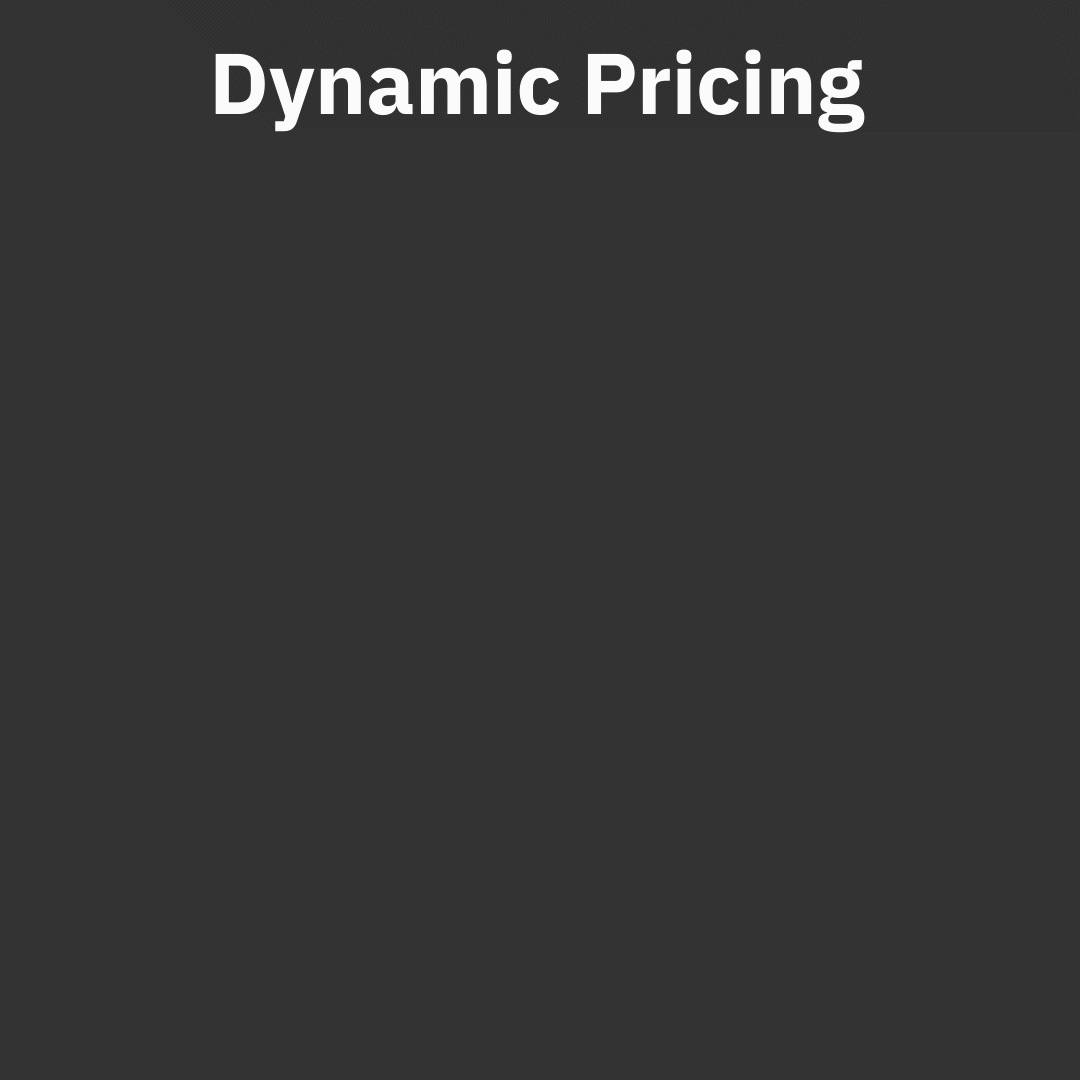

5. Give Prompt Responses
Short-term rental management does not end with listing your property. You have to consistently communicate with your potential guests to provide the with all the necessary information. After a booking is made and your guests arrive, the communication doesn’t stop as they may need to contact you about any unannounced issues or concerns.
Clear and timely communication can set you apart from the competition. Respond to inquiries quickly, ideally within an hour, to create a positive first impression. Use automated messaging tools to send guests pre-arrival instructions and check-in details. For instance, a friendly message that includes local restaurant recommendations can enhance their stay and encourage positive reviews. You can use Property Management Systems to automate guest communication.
6. Encourage Positive Reviews


Positive reviews are the only way to get more guests through the door. It determines your credibility as a vacation rental property manager. Providing an unforgettable guest experience is the only way to encourage great guest reviews.
However, reminding them to do so is important since most people don’t proactively leave reviews if not asked. Do remember to share reviews, ratings, and any other user-generated content on social media to promote your property further.
7. Adhere to Regulations
Understanding local laws and regulations regarding short-term rentals is vital. Make sure to obtain any necessary licenses and pay applicable taxes. For instance, in some cities, short-term rentals are only permitted in certain zones or may require registration with the local government. Being compliant not only protects your business but also builds trust with your guests.
Conclusion
Managing short-term rentals can be challenging, but with the right strategy and approach discussed in this article, you can do it effortlessly. Technology is your best friend when it comes to taking care of property management for short-term rentals.
Leverage dynamic pricing tools like PriceLabs to receive more bookings and earn more revenue per guest.
About PriceLabs
PriceLabs is a revenue management solution for the short-term rental and hospitality industry. It was founded in 2014 and is headquartered in Chicago, IL. Our platform helps individual hosts and hospitality professionals optimize pricing and revenue management, adapting to changing market trends and occupancy levels.
With dynamic pricing, automation rules, and customizations, we manage pricing and minimum-stay restrictions for any portfolio size. Prices are automatically uploaded to preferred channels such as Airbnb, Vrbo, and 110+ property management and channel integrations.
Every day, we price over 400,000+ listings globally across 150+ countries, offering world-class tools like the Base Price Help and Minimum Stay Recommendation Engine. Choose PriceLabs to increase revenue and streamline pricing and revenue management. Sign up for a free trial at pricelabs.co today.




